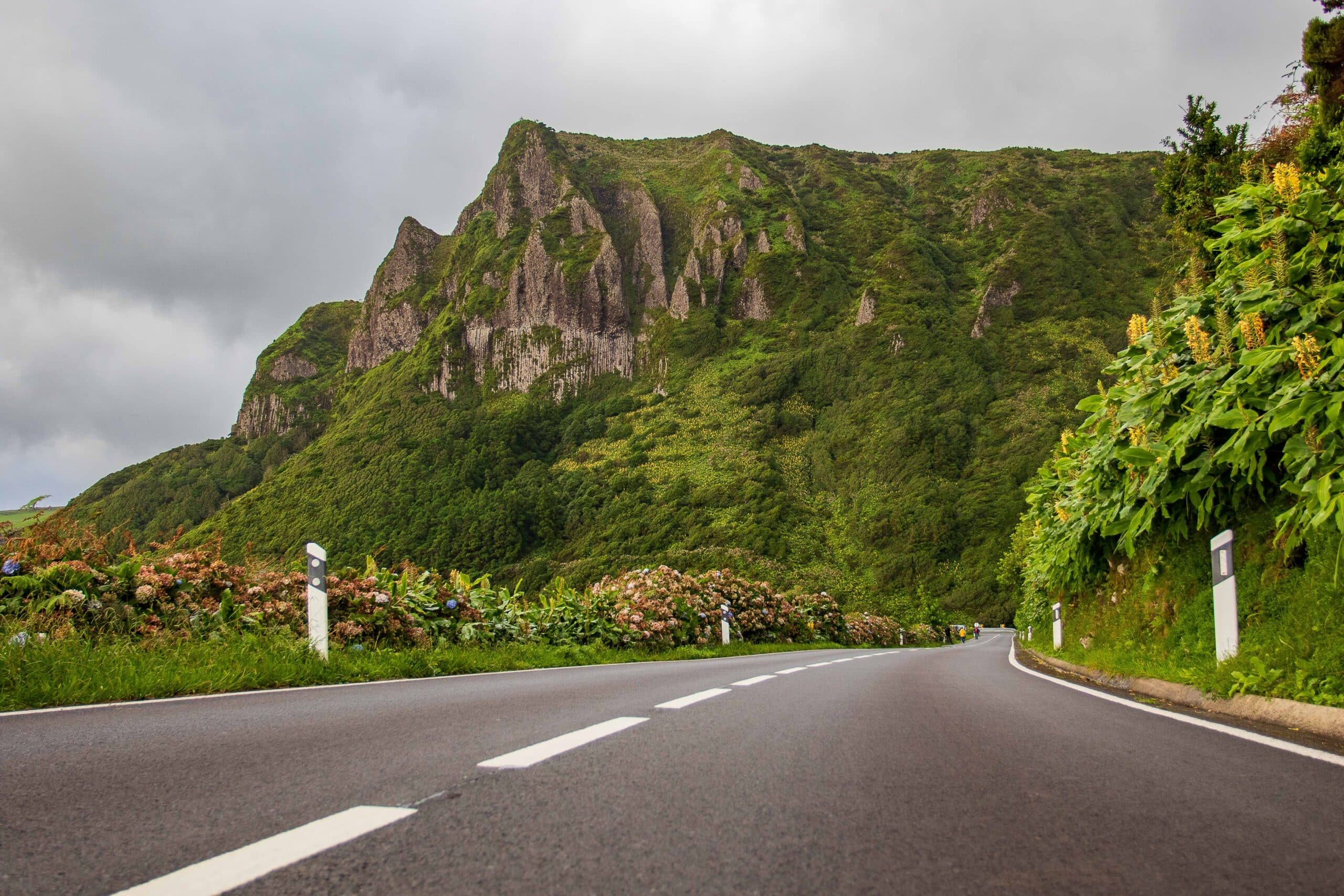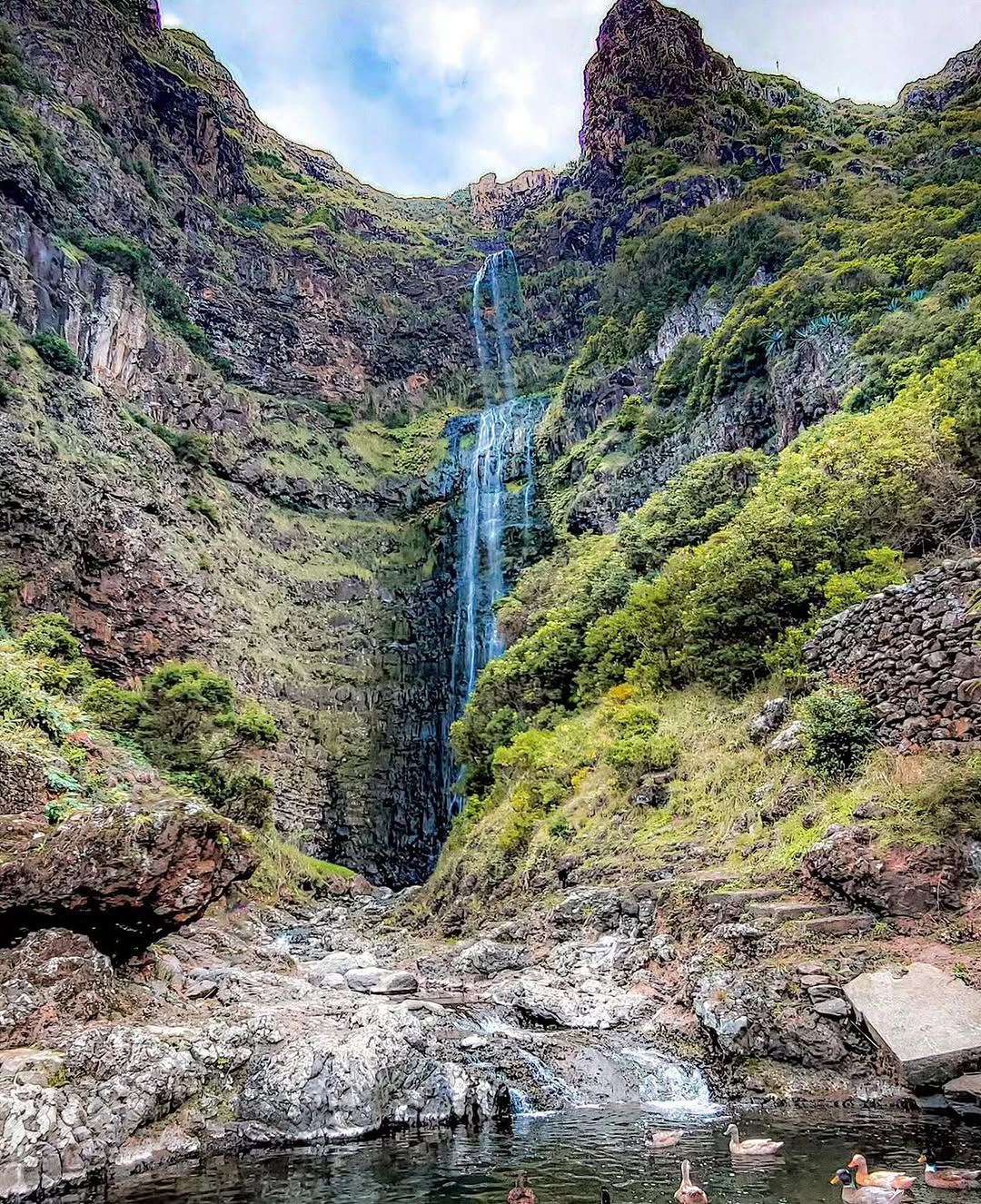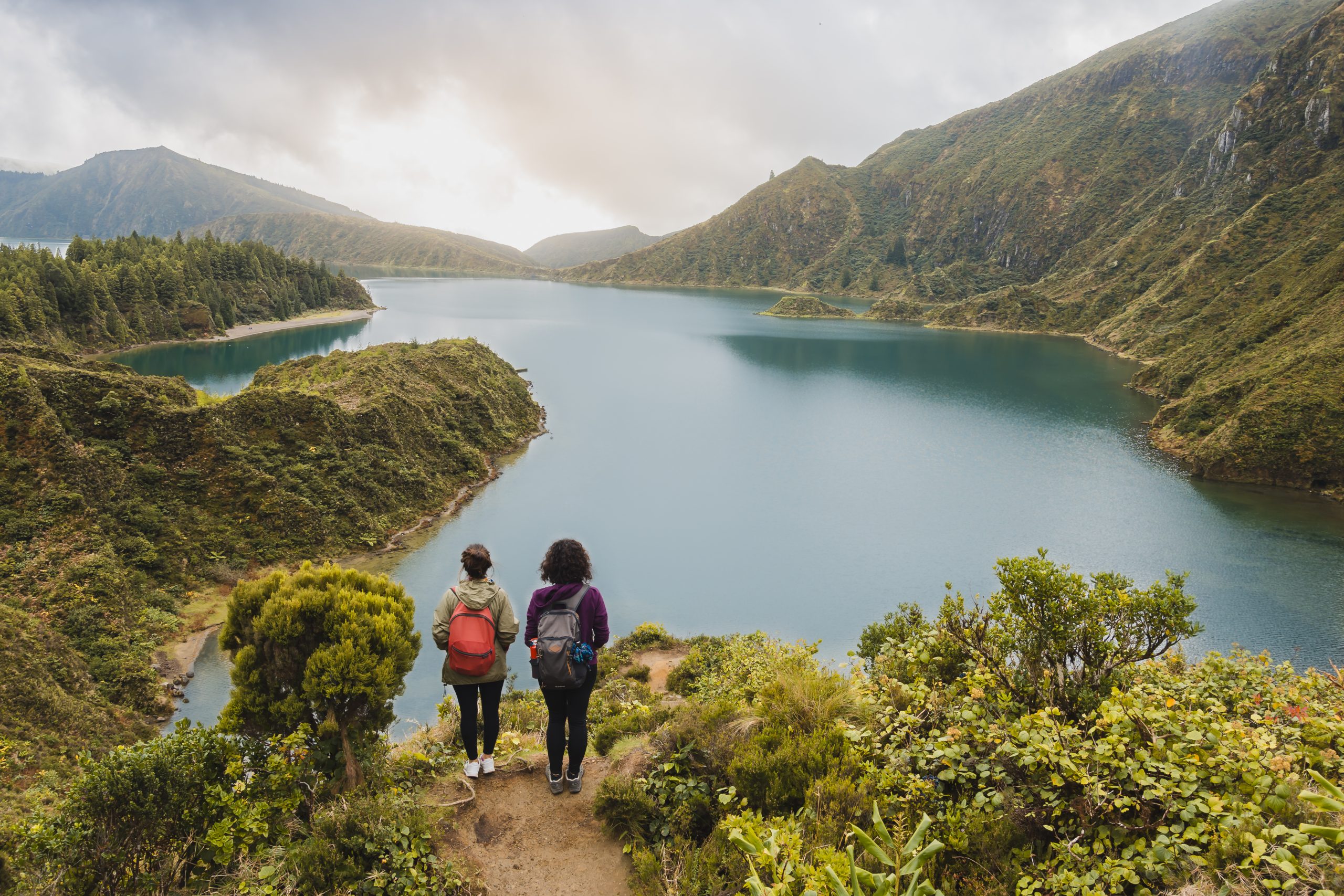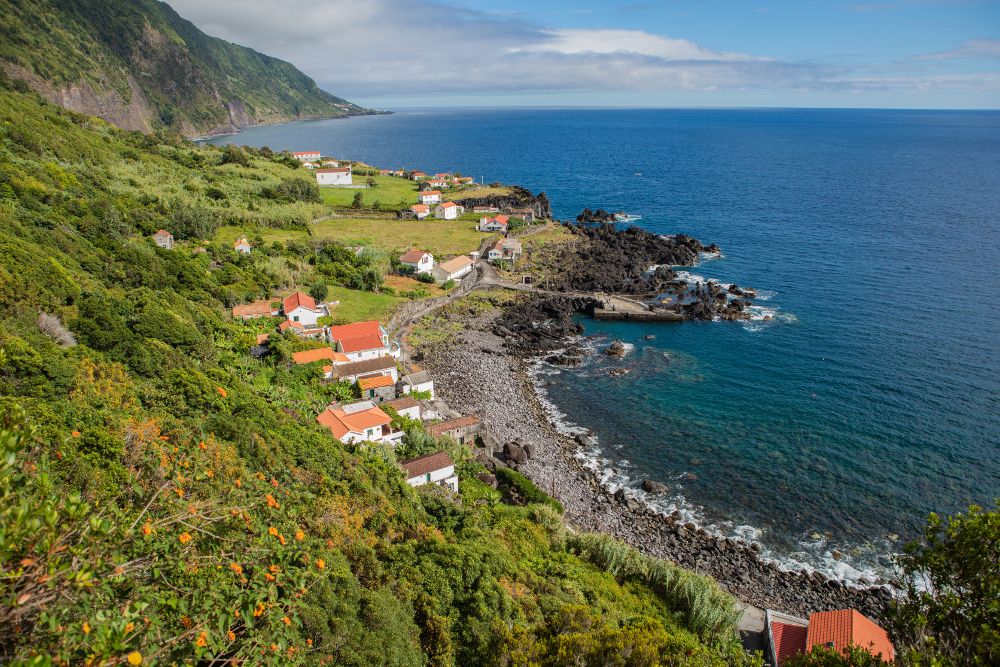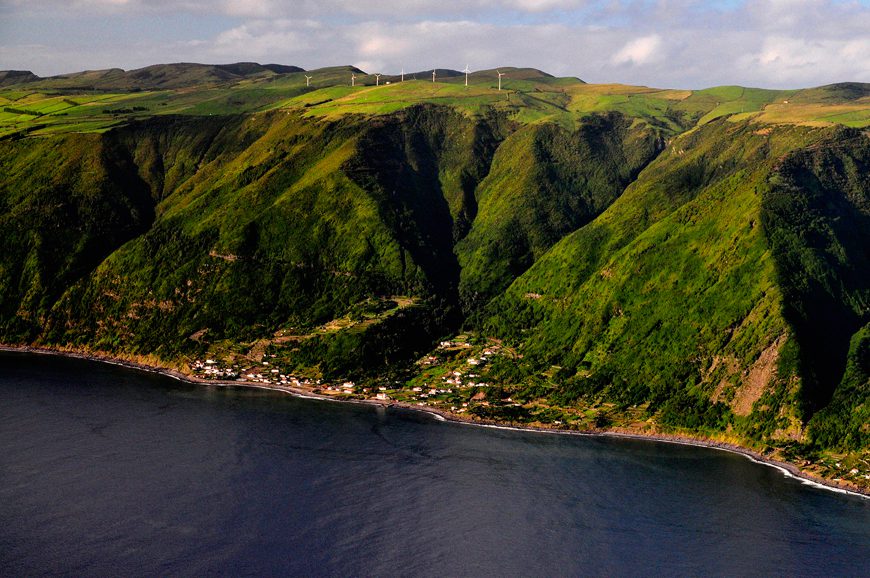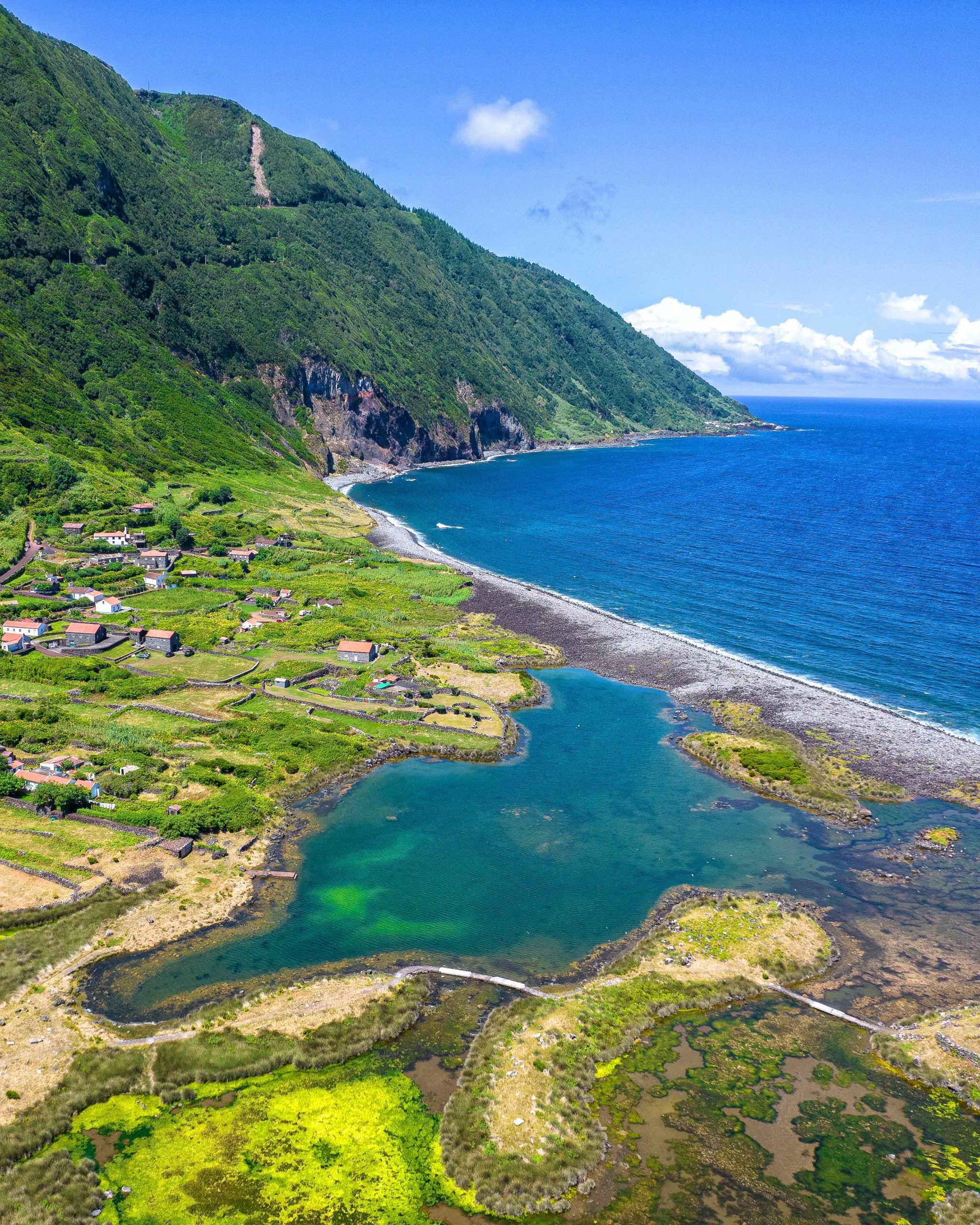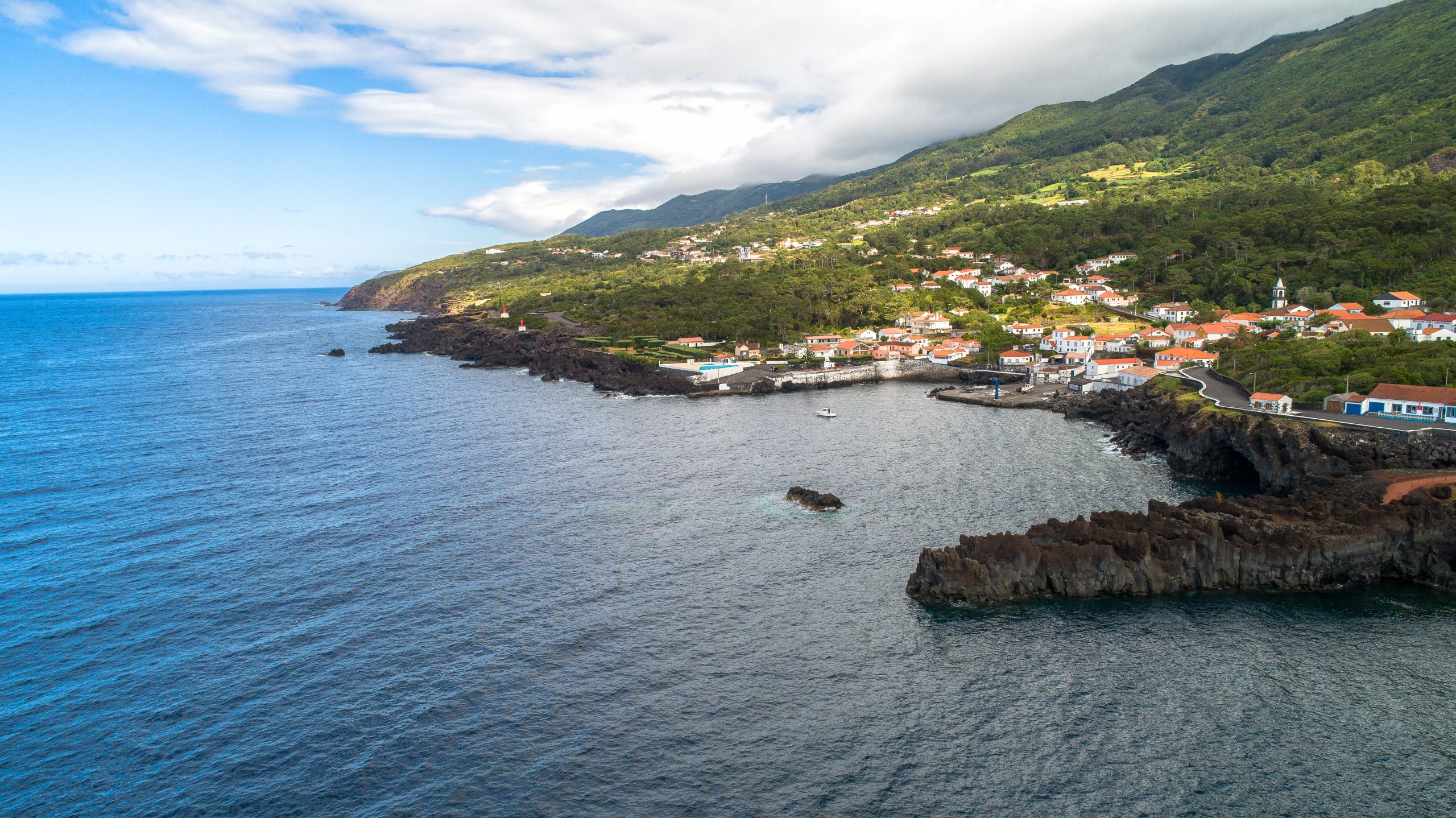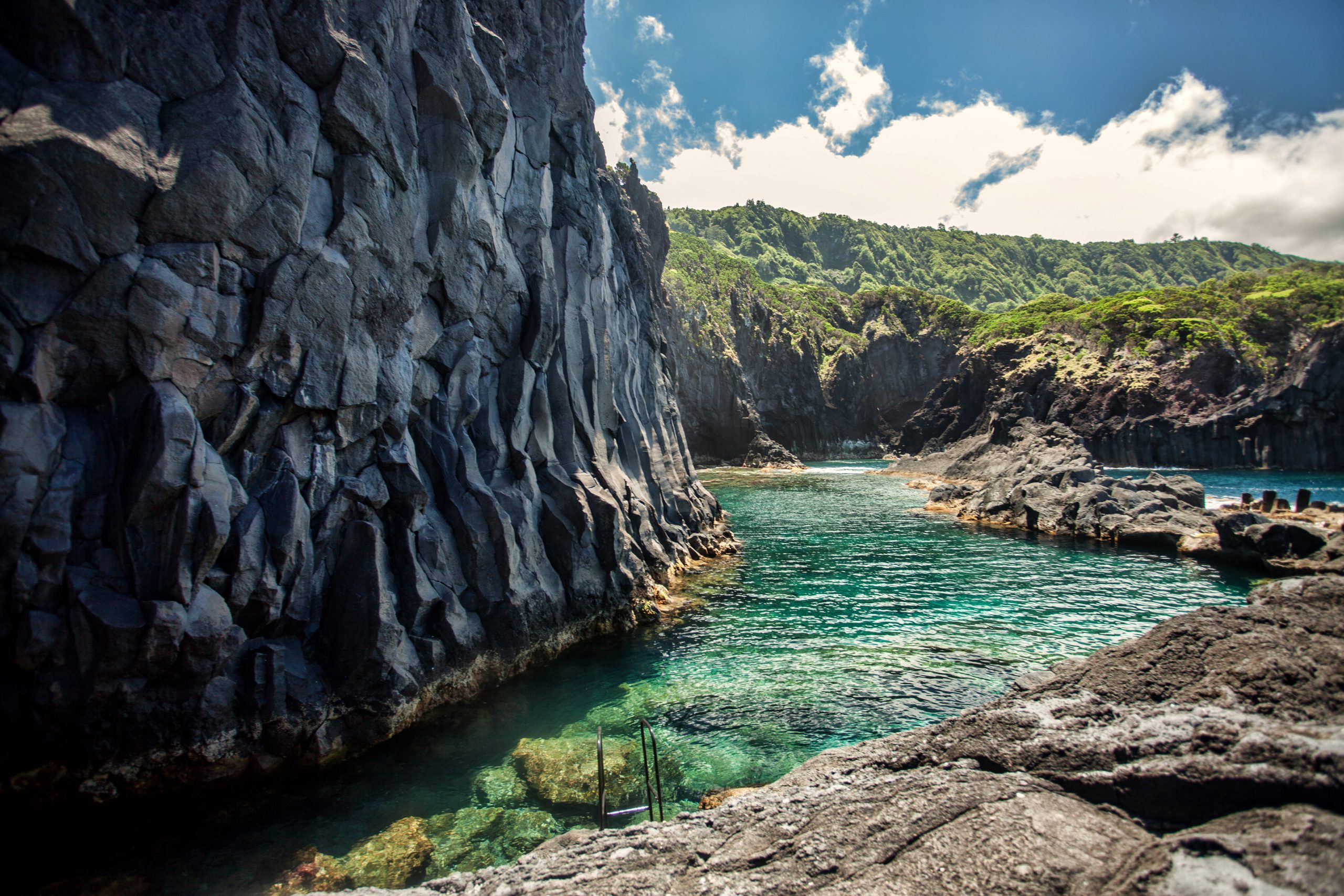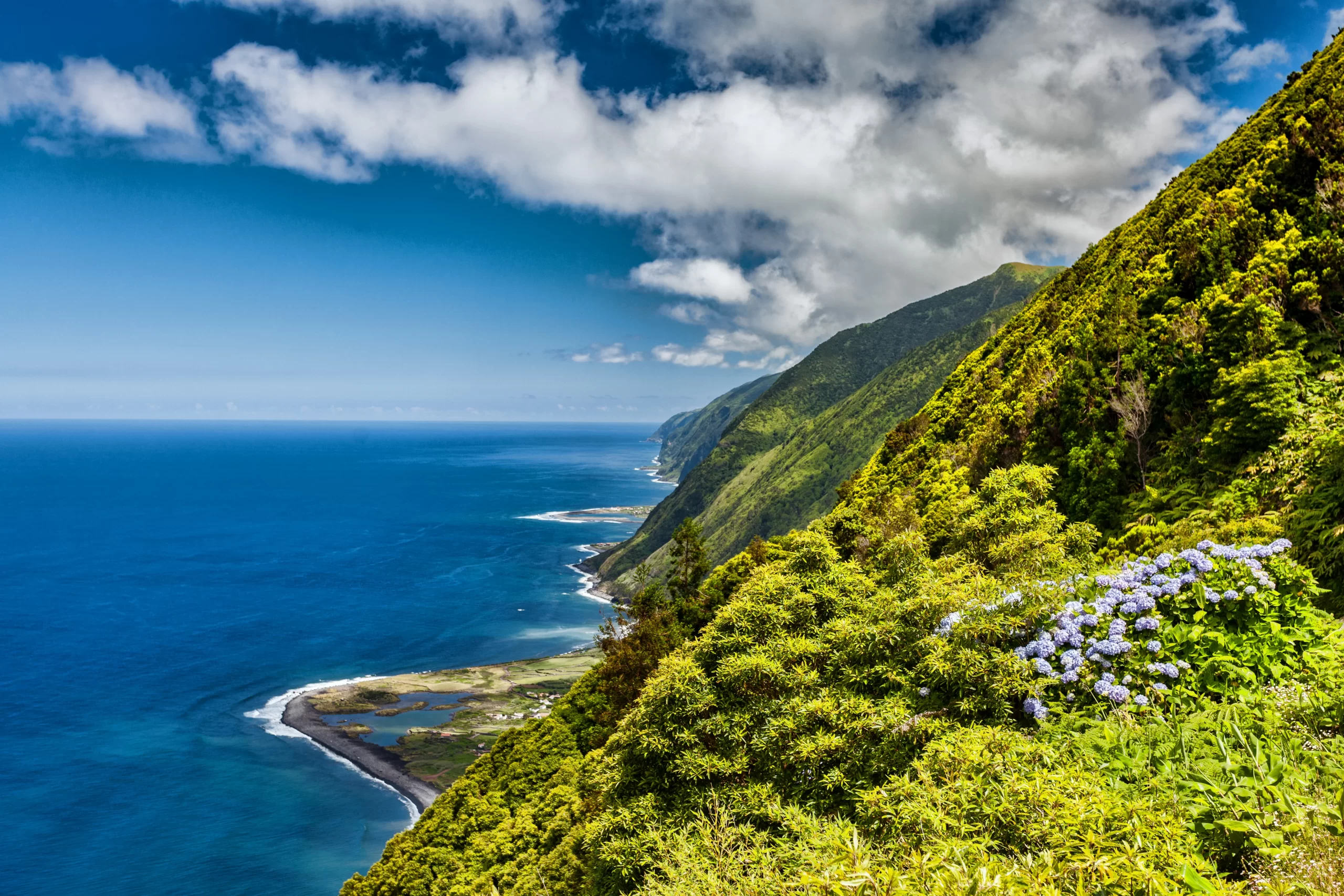São Jorge is the island of fajãs — those little villages stuck between high cliffs and the ocean. Fajã de Santo Cristo is possibly one of the most beautiful and, undoubtedly, the most famous fajãs. It is heavenly, far from urban confusion, pollution, and noise. Time doesn’t exist here, and you can experience a true sense of peace.
Fajã da Caldeira de Santo Cristo is also a nature reserve and a sanctuary for biodiversity. Old stone houses blend seamlessly into the pristine rural landscape, and they are among the most renowned in the archipelago.
One thing is sure: Fajã de Santo Cristo is not made for everyone. Its isolation is what makes it so special. Tranquility reigns here and awakens all our senses. Let’s see what is so unique about this place.
What is Fajã de Santo Cristo?
Geology & Volcanology

Fajã de Santo Cristo is a detrital or slope fajã created by the accumulation of materials resulting from the collapse of the slopes above. It is a flat platform created naturally by the ocean, composed of loose materials that the waves can move. When exposed to the waves, the coast can make some lines of pebbles, forming lagoons, just like in Fajã da Caldeira de Santo Cristo.
Living in a fajã comes with risks of landslides and high exposure to the ocean and its harsh natural conditions. On January 1, 1980, a major earthquake struck the Terceira, Graciosa, and São Jorge islands. The inhabitants of the fajã were severely affected and isolated from the world for three days. After 72 hours, helicopters from the Portuguese Air Force rescued them, and they had to leave everything behind.
History & Geography

Nowadays, there are not many inhabitants at Fajã de Santo Cristo, as few people live there throughout the year. But back in 1890, they were about 110. There was even a primary school at that time. People at the fajã used to grow corn, vines, yams, and cabbage.
Did you know
When electricity was introduced, locals used to live with generators, even in restaurants and accommodations for tourists; it was only in 2020 that they installed cables.
Fajã de Santo Cristo is located in the northeastern part of São Jorge Island and belongs to Calheta’s municipality.
Fauna & Flora

In 1984, the Azorean government designated Fajã de Santo Cristo as a Nature Reserve. It is also a place of international importance under the Ramsar Convention — Convention on Wetlands of International Importance for Aquatic Birds. Indeed, you can easily spot some ducks, common terns, Cory’s shearwaters, geese, and sparrows, among many other resident and migratory birds.
Fajã da Caldeira de Santo Cristo is different from many other fajãs due to the presence of a small lagoon. This lagoon is a protected landscape renowned for being the only place in the Azores where clams (Ruditapes decussatus) can be found. In the calm waters and the ocean, fishermen can catch congers, moray eels, sea breams, mullets, salema, and more species.
On the way to the fajã, you will see some endemic vegetation, such as heather (Erica azorica), Azores juniper (Juniperus brevifolia), and holly (Ilex azorica).

Culture & Festivities

In the village, the Sanctuary of Senhor Santo Cristo church was blessed in November 1835. It is a significant place of cult, where all believers from São Jorge go to pay their promises and ask for grace. This church’s popular party takes place every first Sunday in September. On the program: masses, processions, and many people in town!
Related article → Public Holidays in the Azores 2025: Full List & Travel Guide
What to Do at Fajã de Santo Cristo?
Try Surfing or Stand-up Paddling
Lovers of sea activities and thrilling sensations enjoy the waves behind the lagoon on the coast, where they can practice surfing and bodyboarding against an impressive backdrop — the high hills and the Fajã de Santo Cristo. The conditions are raw and not for everybody. No sand here! The waves crash into the rocks separating the lagoon from the ocean.
The warm waters inside the calm lagoon are inviting for kayaking or stand-up paddling, perfect for those who prefer a leisurely experience without adrenaline rushes.
See the Waterfall of Fajã de Santo Cristo

The waterfall “Cascata Pequena”, also called Cascata da Fajã de Santo Cristo, is located on the way to the fajã on the official trail from Serra do Topo. It is an excellent opportunity to pause and appreciate the beauty of nature during your hike. You can also refresh yourself in the clear waters of the waterfall if you like cold water.
The waterfall is about 10 meters high. The water is present because rainfall accumulates at the water table of Topo’s Volcanic Complex and flows to the ocean after crossing the fajã.
Taste the Local Clams of Fajã de Santo Cristo
The clams of Fajã de Santo Cristo (amêijoas, Tapes decussatus) are unique to this place. They are big and delicious. You can find them at several restaurants around São Jorge island, but the one in the fajã offers them on the menu. They are fresh from the lagoon right nearby.
Clams were introduced in the lagoon about 100 years ago, supposedly by the British working on the telecommunication cables.
→ Explore the authentic flavors of Azorean cuisine in our articles: Bolos Lêvedos | Cozido das Furnas | Grilled Limpets | Massa Sovada | Pimenta da Terra | Gorreana Tea
Visit the Environmental Interpretation Center

This is a small museum where you will find interesting information about the Fajã and other fajãs on many levels: history, geology, biology, and culture. You will be able to see an old oven and related materials, as well as documentaries and testimonials from locals about the 1980 earthquake, and much more.
Best Time to Visit Fajã de Santo Cristo

Best Season to Visit São Jorge Island
The best time to visit São Jorge Island, Azores, is spring (April to June) and summer (July to September).
During this period, the climate is milder, and the temperatures are more pleasant for exploring the region and enjoying the natural landscapes. In addition, the flora will be lush, and many outdoor activities, such as hiking, boat trips, and visits to vineyards and orchards, will be possible.
It’s important to note that the climate in the Azores can be relatively unstable throughout the year, so be prepared for weather variations, even during the warmer seasons.
Check all our articles about the weather in the Azores throughout the year 🌤️ ☔️: January | February | March | April | May | June | July | August | September | October | November | December
Best Time of the Day
Fajã de Santo Cristo is a wonderful place to visit at any time of the day. However, if you want to hike there, it is advisable to begin walking in the morning to spend some time at the fajã before returning. If you have a car, you can park at the neighboring fajã (Fajã dos Cubres), and it will take less time to join Caldeira de Santo Cristo.
The best option would be to spend a night there, as it is a paradisiacal place you can enjoy fully in two days. Then, you will have sufficient time to explore the surroundings thoroughly.
Plan Your Visit to Fajã de Santo Cristo
How to Get to Fajã de Santo Cristo

There are several ways to go to Fajã de Santo Cristo. Once on São Jorge island, take a taxi or drive to Fajã dos Cubres to begin the shorter Fajã de Santo Cristo trail. It is about 4 kilometers long, takes less than 1 hour, and is less challenging than the other option. If you prefer not to walk, it is also possible to take a quad bike.
The other trail, PR1SJO, goes from the countryside of São Jorge Island to Serra do Topo. It takes about 1 hour and 30 minutes to descend to the fajã, which is approximately 5 kilometers long. You will go from the mountains to the ocean and be surrounded by pure nature, with Terceira and Graciosa islands in sight and cows on the way. However, there is a 700-meter drop in level.
Planning a trip to the Azores? These articles will help you: How to Get to the Azores 🗺️ | Azores airports 🛬 | Flights between islands ✈️ | Ferries between islands ⛴️ | Which island to choose? 🏝️ | What airlines fly to the Azores? 🛩️
What to Bring to Fajã de Santo Cristo
If you are hiking or plan to spend the night at Fajã de Santo Cristo, it is advisable to bring some snacks and food to cook. There is only one restaurant in the fajã, and it fills up quickly, especially during the summer.
Water, good shoes, hiking sticks, waterproof jackets, and sportswear are also recommended for hikers. Furthermore, take a book with you to enjoy the peaceful atmosphere of the village and its beautiful scenery. A swimsuit is also a must-have for a dip in the lagoon!
Azores Guide Book
Azorean Language & Phrases 🗣️ | Currency & Banks 💵 | Credit Cards & Traveler’s Cheques 🏧 | Driving in the Azores 🚗 | Electricity 🔌 | Experiences & Tours 🗺️ | Health & Safety 🩺 | Internet & Wi-Fi Access 🛜 | Phones & Mobile Service 📞 | Post Offices & Buying Stamps ✉️ | Public Holidays 🏖️ | Shopping 🛒 | Time & Daylight 🕒 | Whale Watching Guide 🐳 | Best Island to Visit 🏞️
Where to Eat
If you need somewhere to eat near Fajã de Santo Cristo, click here. In this link, you’ll find the 10 best restaurants on TripAdvisor.
Where to Stay
To make your life easier, we’ve filtered the search by:
Pro Tips

For a complete experience, we recommend spending a night at the fajã and enjoying this unique place. You will experience beautiful and peaceful moments close to nature and the friendly locals of São Jorge.
To leave the fajã, consider taking a quad bike instead of hiking back! The locals will drive you and your luggage to Fajã dos Cubres; from there, you can take a taxi to the island’s main towns.
Nearby Attractions
Fajã dos Cubres

Dotted with traditional stone houses, Fajã dos Cubres is a perfect example of a typical fajã and is photogenic. Stroll in the narrow streets of this wonderful place in such an unlikely place. Don’t forget to visit the century-old church.
The houses fit perfectly in the landscapes. You will not find any buildings that are higher than two floors or supermarkets. The high cliffs protect the village perfectly and open towards the ocean. It is a very peculiar way of life. To protect the inhabitants from the sea, you will see the natural protection all around: black pebbles. Everything about Fajã dos Cubres makes it a special place.
Velas

Velas, the largest town on São Jorge Island, stands out for its rich historical, cultural, and religious heritage. Museums, churches, and ancient forts contribute to the town’s architectural diversity. They invite visitors to explore its charming streets. Visitors can wander through the streets and uncover the town’s essence.
Affectionately known as the ‘Cheese Capital of the Azores’, Velas is a top destination for cheese lovers. Visitors can taste the renowned São Jorge cheeses, one of the region’s most iconic products.
For nature lovers, Velas offers unique experiences by the sea and inland. The Natural Pools of Poça dos Frades and the Preguiça Bathing Area offer swimmers crystal-clear waters surrounded by volcanic rocks. Visitors enjoy breathtaking views of the Pico and Faial islands while swimming in the calm waters.
The town is also a gateway to the island’s iconic fajãs, which offer stunning and authentic landscapes:
- Fajã do Ouvidor: Famous for the Poça Simão Dias natural pool.
- Fajã d’Além: A peaceful retreat with orchards full of fruit trees.
Velas has something special for you, whether you’re seeking history, gastronomy, or natural beauty!
Pico da Esperança Viewpoint

Pico da Esperança Viewpoint is the highest point of the island and offers the best views. From up there, observe the “dormant dragon” and the other four islands around. On a cloudless day, it is quite a fantastic panorama.
Coffee Plantations at Fajã dos Vimes

On the south coast of São Jorge Island, one of the fajãs grows coffee. The Nunes family owns the only coffee plantation in the Azores behind their house. They invite people to taste the delicious aromatic drink and visit the plantation, one of the island’s most popular attractions.
The frequent rains at Fajã dos Vimes create a microclimate perfect for agriculture. UNESCO protects this fajã as a Biosphere Reserve.
Check all our articles about each one of the most relevant points of interest on São Jorge Island: Urzelina | Fajã do Ouvidor | Fajã de Santo Cristo | Fajã dos Cubres | Poça Simão Dias | Top Places to Visit in São Jorge Island | Miradouro Vigia da Baleia
Complementary Information
Best Season to Visit the Azores
The Azores Archipelago boasts a unique climate that shapes its lush landscapes, making it a splendid year-round destination. With mild temperatures and minimal fluctuations, each season offers something unique. Spring averages 16 °C, summer reaches 21 °C, autumn cools to 18 °C, and winter remains mild at 14 °C.
→ For a detailed breakdown of the weather by month, check the following links 🌤️☔️: January | February | March | April | May | June | July | August | September | October | November | December
How to Get to the Azores
The Azorean Archipelago is easily accessible through numerous flight routes. Lisbon and Porto are the main entry points to the continent, with direct flights available to São Miguel (PDL), Terceira (TER), Faial (HOR), Pico (PIX), and Santa Maria (SMA). To find the best flight, use search engines like eDreams or Skyscanner. These platforms let you compare prices and schedules from multiple airlines in one convenient location.
For more details on how to get to the Azores, take a look at our complete guide. But what if you want to explore beyond your arrival island? We’ve got you covered!
- Azores airports 🛬
- Flights between islands ✈️
- Ferries between islands ⛴️
- Which island to choose? 🏝️
- What airlines fly to the Azores? 🛩️
→ Once you’ve found the perfect route, book your tickets and get ready to experience one of the world’s most stunning island groups!
Travel Essentials
Essential Information for your Azores trip: Azorean Language & Phrases 🗣️ | Currency & Banks 💵 | Credit Cards & Traveler’s Cheques 🏧 | Driving in the Azores 🚗 | Electricity 🔌 | Experiences & Tours 🗺️ | Health & Safety 🩺 | Internet & Wi-Fi Access 🛜 | Phones & Mobile Service 📞 | Post Offices & Buying Stamps ✉️ | Public Holidays 🏖️ | Shopping 🛒 | Time & Daylight 🕒 | Whale Watching Guide 🐳 | Best Island to Visit 🏞️
Useful Tools & Apps
The weather in the Azores can be variable, so it’s helpful to use some apps before visiting the islands. Spotazores provides live camera feeds from the main tourist attractions, allowing you to check the weather and plan your visit. For accurate weather predictions, use Windy or Windguru — they provide the most reliable predictions.
Video
Conclusion
In conclusion, Fajã de Santo Cristo is simply magical. The silence there is suitable for your mind and soul. It might be the most sought-after place on São Jorge island, but only the most curious travelers end up hiking and taking their time there.
Visiting São Jorge and not Fajã da Caldeira de Santo Cristo seems impossible. However, the truth is that most people will only stay for a day and then return to their busy lives. Fajã de Santo Cristo is a treasure not everyone will appreciate. But if we are certain about one thing, it will surprise everyone, whether they like it or not. It is a true gem for the senses.
Authors’ Note
I am pleased to inform you that all the recommendations in this article are based on my personal experience and observations. As the author, I have personally visited each attraction mentioned, ensuring that every suggestion is grounded in first-hand knowledge and genuine enthusiasm.
FAQs
Access to the fajã is only possible on foot or by quad bike. The most popular trail starts from Serra do Topo and offers stunning views along the way. Luggage transport can also be arranged using appropriate vehicles.
Located within an ecological reserve, the fajã is renowned for its clam cultivation — a unique delicacy in the Azores — and its waves, ideal for surfing and bodyboarding. It’s also famous for its natural beauty and peaceful ambiance.
In addition to water sports like surfing, visitors can explore hiking trails, admire the lagoon, and enjoy the area’s serenity. It’s perfect for those seeking a disconnected experience, away from urban conveniences.
Simple accommodations are available for those seeking stays close to nature, ideal for individuals who appreciate solitude and tranquility. The area is rustic, with limited electricity and no luxury amenities.





